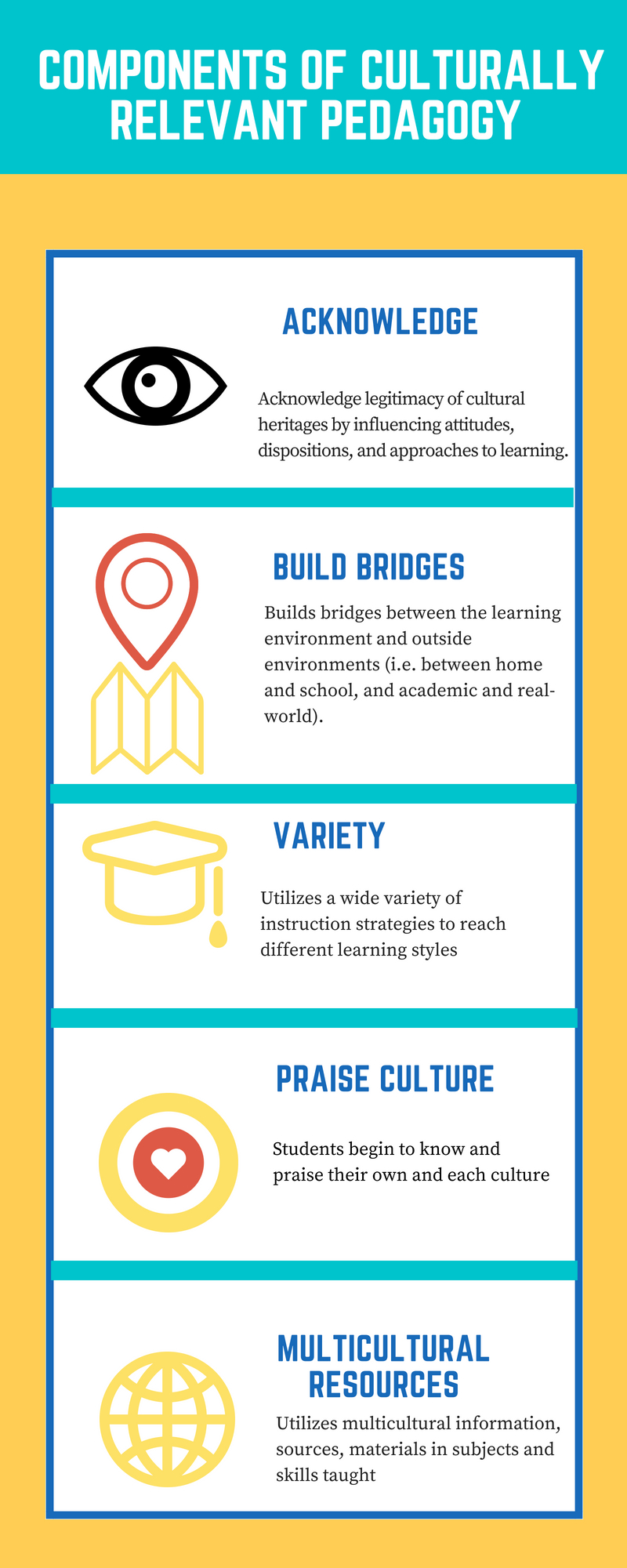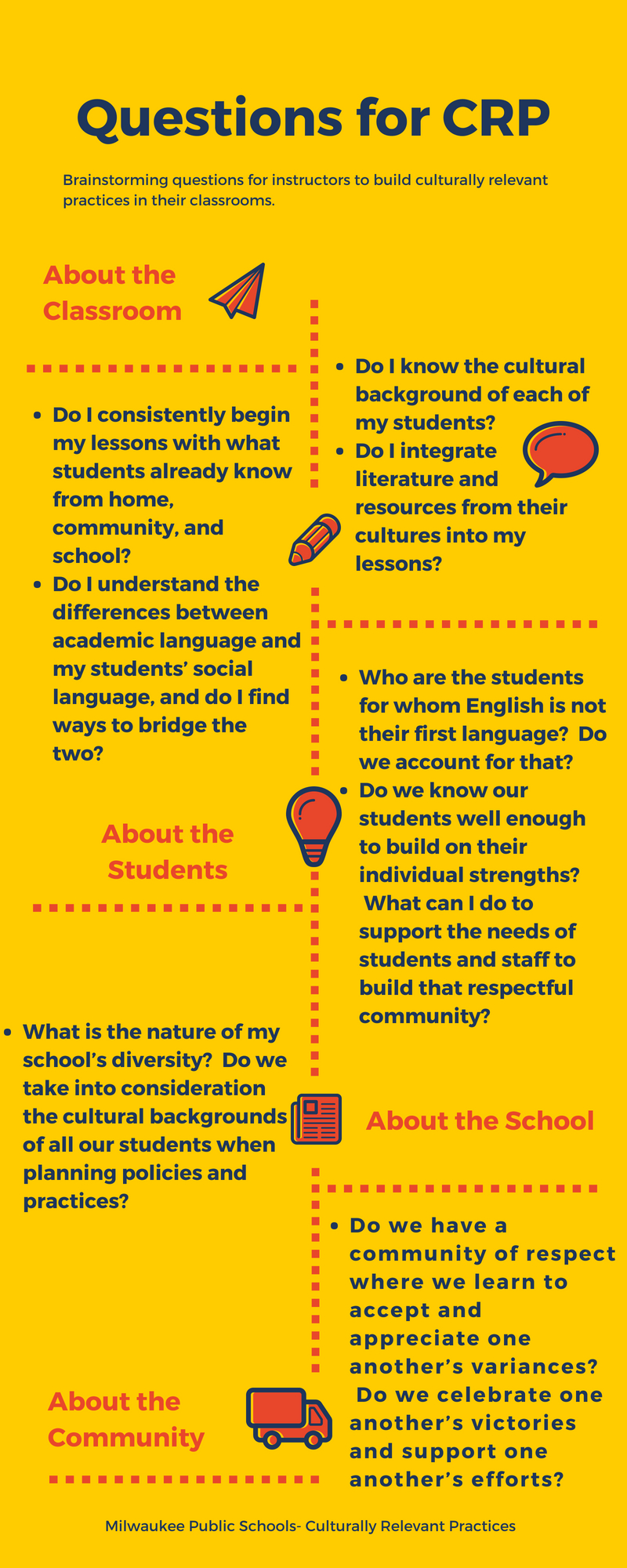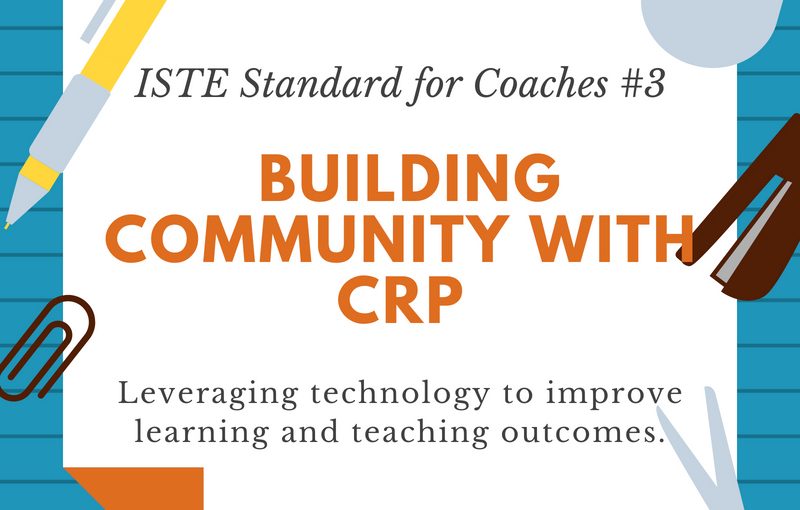How you learn is built in to the larger part of who you are, embodies your collective experiences, norms, beliefs, and values; it is a part of your culture. Building community in the learning environment, whether on- or off-line, establishes safety, facilitates collaboration, and can help cultivate sense of self and role in the community. The ISTE standard for coaches calls coaches to “create and support effective digital age learning environments to maximize the learning of all students… by model[ing] effective classroom management and collaborative learning strategies to maximize teacher and student use of digital tools and resources and access to technology-rich learning environments”,(ISTE, 2017). In order to maximize these resources for learning, we need to establish a technology environment that engages students’ cultural background and understandings.
Building community can be particularly difficult in an online environment where social cues, particularly non-verbal ones, may be more challenging to interpret or oftentimes gets misinterpreted. This becomes confounded when factoring in cultural languages and exchanges. These exchanges are not limited to ethnic cultures, but also generational cultures where task interpretations may take on different meanings. For example, assigning students the task of investigating three community food resources may be interpreted and approached differently by students who are very familiar with technology, as opposed to non-traditional students or students that have limited access to technology. Coaches can help instructors build understanding of the cultures present in a classroom, and implement successful learning strategies through culturally relevant pedagogy (CRP).
What is CRP and why is it important?
McCarther defines culture as an “amalgamation of human activity, production, thought, and belief systems,”(McCarther, 2017). “Culture is fundamental to learning,” (Pitsoe, 2014). Each student brings to the classroom a “fund of knowledge” shaped by their culture that influences who students are, what they believe, and how they think, (Cavalli, 2014). It is easy to understand that students bring all of themselves represented through culture in their learning, but does how they are taught represent them and their culture? In 1995 researcher Gloria Ladson-Billings coined the termed “culturally relevant pedagogy” (CRP) in response to the fact that students learn best when their ideas and voice are shared and appreciated by the world, (McCarther, 2017). CRP invites educators to create socially just spaces and structure for students to share their voice by using teaching strategies that support the use of cultural knowledge, previous experiences, and unique performance styles that are familiar to diverse students in the classroom, (Cavalii, 2014 & McCather, 2017). According to Ladson-Billings, student learning success encompasses academic success, cultural competence, and sociopolitical consciousness. CRP is not prescriptive but rather flexible and ever-changing in response to the cultures unique to a particular classroom, (McCather, 2017). Good implementation of CRP in the classroom involve four key components as described by Pitsoe and summarized in Figure 1.1 below.

Understanding how students learn, the reality of their world today, and what skills they need to challenge the existing systems is crucial to the implementation of CRP.
Need for CRP in Nutrition
The need for CRP in nutrition education is great. Nutrition is incredibly personal as we all eat certain foods for a variety of different reasons. Most reasons for eating are linked to social and cultural norms rather than a strong connection to health (though cultural eating is linked to maintenance of health). Nutrition practitioners and educators need to be aware of the delicate interplay between culture and health as new foods and traditions are introduced to the diet. Presenting nutrition information in a culturally relevant manner helps engage individuals by giving them the appropriate context and tools to facilitate change. Below are two examples that help illustrate the need for CRP in nutrition counseling:
In the article, “Culturally tailored post secondary nutrition and health education curricula for indigenous populations”, the authors investigate the types and number of culturally relevant nutrition and health programs offered to students seeking to work with Alaskan natives and studying for an allied health degree. There is a need for such training as Alaskan natives currently face a disproportionate rate of chronic disease development, particularly when Western diets substitute the traditional diet, (McConnell, 2013). After a brief review, the authors found very limited curriculum related to culturally appropriate/relevant nutrition counseling that included spirituality, respect of elders, and personal relationships with the land, waterways, and animals, (McConnell, 2013). The information that they found was limited to stand-alone culturally tailored courses that the authors argued were considered “dead-end” trainings that were short term and only offered non-transferable skill-building, (McConnell, 2013). After a more comprehensive search, the authors found limited offerings of post-secondary training that resulted in a mainstream credential. Reasons for the limited availablity were hypothesized to be possibly related to funding, oral culture, researchers available for study, or a mix of the above, (McConnell, 2013).
The authors’ rationale for culturally tailored curriculum is very interesting, arguing that the more effective nutritional counseling approach was not to create courses for the indigenous patients themselves, but rather train future nutritionists/dietitians with additional credentials to tailor teachings that align with the food norms and beliefs of the target population. This correlates with the CRP theory principles in which states that is the role of the instructor to understand the culture of the class/client, not the client/student, as it is more effective to receive education in a context that is culturally familiar and resonates better with clients, (Pitsoe, 2014).
When considering my own education options, to my knowledge, there isn’t post-secondary continuing education ending in credentials available for nutritionists/dietitians on culturally appropriate/relevant counseling. However, when implemented well, CRP can deliver results. Another article, “Adaptation of a Culturally Relevant Nutrition and Physical Activity Program for Low-Income, Mexican-Origin Parents With Young Children”, described a community intervention nutrition program designed around the “Social Learning Theory” to help low-income hispanic families decrease rates of childhood obesity. This 5-year program gave individuals in the intervention group $25 a month to spend on fresh fruit and vegetables while participating in family nutrition and physical activity nights. As part of the model, the researchers used the “Anchor, Add, Apply, and Away” approach where participants would share food memories from childhood, share stories of life as an immigrant, problem solve by learning to make a new recipe with local foods, and share what was learned at the end of the process, (Kaiser, et. al., 2015). Parents were also asked to provide examples of what they did to promote nutrition and physical activity in their family. This served to give ideas and motivate others in the group. At the end of the program, parents reported that children spent less time watching tv or playing video games, did more physical activity, and either maintained weight or lost weight, (Kaiser, et. al., 2015). This article explores a patient-centered approach to culturally relevant nutrition education where success was gained not only through cultural food norms and values, but also encouraged the exploration of new foods through the social learning theory.
Implementation of CRP in Nutrition Classes
There is a demonstrated need for more culturally relevant pedagogy in nutrition education, particularly considering that using the same teaching techniques on all students does not set up these individuals for sustainable success when cultural aspects to nutrition are not fully incorporated. This begs the question: What are some approaches and examples of using culturally relevant pedagogy in nutrition classes?
According to Pitsoe, in order to maximize learning, teachers must first understand the cultures represented in their classrooms and use that understanding into their lessons, (Pitsoe, 2014). To help with this, the Milwaukee Public Schools offers a list of questions to help teachers gain a better understanding of their students. Figure 1.2 examines these questions.

Once the class culture is understood, the next step is to select instruction strategies that effectively engage that culture. Some ways that teachers have successfully implemented this is by using cultural mythology to open discussions about a topic, conduct an environmental study of pollution in local community, or investigate the nutrition status of the local community, (Cavalli, 2014). These strategies could also be expanded to include discussions on the impacts of technology on food culture and generational culture.
A master’s thesis by A.C. Cavalii, provides an fuller example of CRP as implemented in an urban science class setting. Her approach to CRP involved taking an eleven-lesson unit and blending strategies to incorporate not only direct teaching but also guided inquiry, and community investigation. A summary of her approach can be found in Figure 1.3 below.

By modeling and providing examples for instructors on building culturally relevant lessons, coaches can help teachers better develop online strategies that incorporates cultural relevance to enhance learning and build better online communities.
References
Cavalli, A. C., (2014). Teaching nutrition and health in the urban science classroom- A blended approach to culturally relevant and problem based learning. Education and Human Development Theses, The College at Brockport [website]. Available at: https://digitalcommons.brockport.edu/cgi/viewcontent.cgi?article=1547&context=ehd_theses
ISTE, (2017). ISTE standards for coaches. Available at: https://www.iste.org/standards/for-coaches
Kaiser, L., Martinez, J., Horowitz, M., Lamp, C., Johns, M., et al. (2015). Adaptation of a culturally relevant nutrition and physical activity program for low-income, Mexican-origin parents with young children. Center for Disease Control [webpage]. Available at: (https://www.cdc.gov/pcd/issues/2015/14_0591.htm)
McConnell, S., (2013). Culturally tailored post secondary nutrition and health education curricula for indigenous populations. Int J Circumpolar Health. Available online at: https://www.ncbi.nlm.nih.gov/pmc/articles/PMC3748461/)
Milwaukee Public Schools, (n.d.). Culturally responsive practices. Available at: http://mps.milwaukee.k12.wi.us/en/Families/Family-Services/Intervention—PBIS/Culturally-Responsive-Practices.htm
